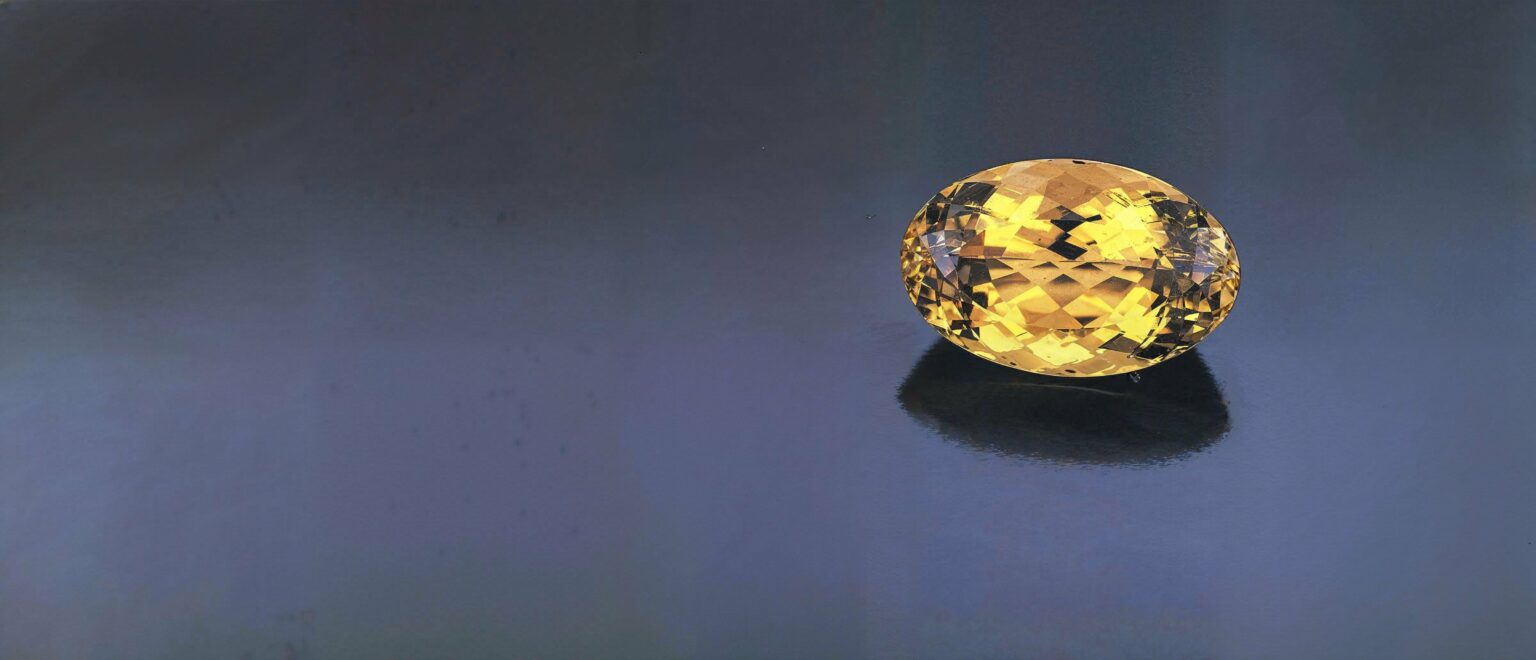Test your gem marketing skills by solving this problem based on actual history:
It’s somewhere around 1913. You work for a German mining company that has just discovered a fat pocket of stunning golden beryl (the same family to which emerald and aquamarine belong) in South West Africa (now Namibia). The problem posed by the new find is this: How do you arouse public interest in a very obscure, albeit beautiful stone?
Well, first you give it a name that suggests the gem possesses a quintessential yellow color. That name: “heliodor,” a Greek-derived word that means, in effect, “sun-stroked.”
Once you’ve got a jazzy name for your beryl, you then set out to capture worldwide publicity for the gem. So you commission a well-known artist—in this case, Lucas von Cranach—to design a heliodor jewelry ensemble and present it to Kaiser Wilhelm II of Germany and his wife in 1914. Voilà, instant headlines everywhere.
But now you’ve got to keep the momentum going for your heliodor-brand golden beryl without allowing interloper stones from other deposits to benefit. What do you do? In this case, you claim your company’s beryls are blessed with unique gemological properties (even though they aren’t) that set them apart from species members found in Brazil and Mozambique. Among other things, you spread the word that heliodor phosphoresces blue when zapped with cathode rays, changes color like alexandrite between daylight and artificial light and is even a touch radioactive.
The end result of all your marketing efforts is this. In no time at all, heliodor is the talk of the whole gem world, briefly popular in a way it has never been before or, alas, after—and modern admirers fear, may never be again. “It’s difficult enough to excite people about yellow gems in general, let alone golden beryl in particular,” says Dick Greenwood, A.F. Greenwood Inc., New York. “Earth tones would have to catch on in a big way.”
Uninspiring Color
Even if earth tones were to catch on, golden beryl would probably struggle for a piece of the action in yellow and golden gems that would result. There are a lot of reasons why the going would be rough for this gem.
At present, most golden beryl, or “heliodor” if you will, is found in Brazil, a country whose beryls are probably better known for their quality than any quality. Indeed, many otherwise useless pale Brazilian-beryls are being irradiated.
What ails run-of-the-mill Brazilian golden beryls? Laurie Watt, Mayer & Watt, Beverly Hills, Calif., says that their color is “an uninspiring legal-pad yellow.” She means that its yellow tilts ever so slightly to green, a trait that prevents this beryl from faring well in side-by-side comparisons with another far-better-known Brazilian yellow gem, citrine.
And it doesn’t even matter that the yellow of golden beryl, as Greenwood points out, is purer than that of citrine. It still seems dull when compared to that quartz’s virile brown to orange-brown undertone.
Maybe if the prices of better Brazilian golden beryl were more on a par with those of citrine, there might be more demand for this gem. At present, however, handsome yellow citrine in popular 3- to 10-carat sizes is readily available to jewelers at $10 per carat and less while comparable-grade Brazilian golden beryl is quoted to us at $40 to $60 per carat in the same size range. “Who’s going to pay such a high price for a stone that reminds everyone of a quartz?” asks Greenwood.
African Exceptions
From time to time, golden beryls with the kind of deep, intense color that inspired the name “heliodor” make their way to the market. Almost invariably they come from Africa, which has a knack for producing bright beryls that some dealers who are heliodor aficionados liken to sapphire.
Around five years ago, a small find of golden beryl, rumored to have come from East Africa or Madagascar, set dealer juices running for this gem in a way Brazilian stones never do. “The color reminded me of a banana peel,” says Watt, who wears a dazzling African golden beryl set in a piece of heirloom jewelry given to her by her husband, Simon. Only one or two stones from the dozens they bought of this material remain in their inventory.
Roy Albersr, a buyer for Tiffany & Co., New York, also remembers the African find with affection. He likens the yellow of these beryls to that of a bright lemon and wishes for more.
Given the kudos African beryl earns from dealers, plus its rarity, it is hardly surprising to hear that this variety routinely fetches $80 to $120 per carat in better-to-fine qualities. So highly prized is that Paul Haubert, Inter-Ocean Trade Co., New York, believes the term “heliodor” should be reserved specifically for beryls of this caliber. “The word connotes a fine yellow-golden color,” he says.
The Irradiation Controversy
Not every bright golden beryl in dealer stocks today owes its color to African origin. Some might have found their fabulous hue in a gamma cell or a linear accelerator—at least, that is what many dealers suspect.
No one we talked to knows exactly how long or often treaters have been bombarding golden beryl. We’ve heard guesses of up to 25 years. But, according to scholar John Sinkankas’ superb, compendious 1981 book, “Emerald and Other Beryls,” successful experiments with X-ray and gamma-ray irradiation of colorless beryl (called “goshenite”) to turn it yellow date back to 1908.
In any case, since irradiation of golden beryl is currently undetectable, some companies like Krementz Gems Newark, N.J., feel obligated to operate under the assumption that all stones may be irradiated.
Given the fact that dealers suspect golden beryls of having been irradiated, it is advisable for jewelers who sell this gem to mention this possibility to customers, even though the enhancement is generally believed to be safe and permanent.
There have already been two recent lawsuits against jewelers involving non-disclosure of heating methods to sapphire. Since irradiation is an even more sensitive subject, jewelers who sell heliodor should protect themselves by revealing the possibility that the beryl may have been enhanced by this method.
Please note: this profile was originally published in 1992 in Modern Jeweler’s ‘Gem Profiles/2: The Second 60’, written by David Federman with photographs by Tino Hammid.
The 24.8-carat golden beryl shown in the header image was courtesy of House of Onyx, Greenville, Ky.






